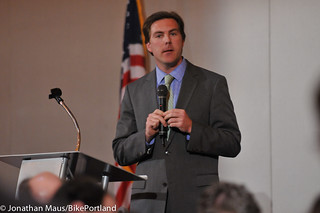During a speech at the Oregon Active Transportation Summit in Salem yesterday, PBOT Director Tom Miller got advocates up to speed on the funding crisis at the agency and organizational changes they’ve made that could reap benefits for bicycling. In addition, Miller made the unexpected announcement that PBOT will soon roll out a formal 10% bike mode split goal, a step in accountability he says is unprecedented.
Miller said PBOT is being forced to adapt and change due to a “crisis in transportation” that revolves around funding. He said Portland has a 21st century transportation vision they are trying to carry out with a 20th century funding model.
“Therein lies the challenge,” he explained. “We know what we want to be doing, we know how to do it, and we are well on our way, we just lack the funding stability.”
“We’re going to tell you how we’re going to get there [to 10% bike use]. That’s new. PBOT’s never done that before.”
— Tom Miller
The problem is (as many of you already know) an over-reliance on state gas tax revenue. But not everyone believes that line. Perhaps answering to critics that say PBOT is to blame for its financial problems because they committed to major expenditures (like the Sellwood Bridge, sidewalks, and the Portland-Milwaukie light rail project) whose bills are now coming due, Miller explained they based those decisions on ODOT projections that are vastly lower than expected.
ODOT raised the gas tax six cents per gallon in 2009 (the first increase since 1993). After doing so, they estimated the City of Portland would bring in about $300 million in new revenue. But in 2011, Miller explained, “the numbers came back at $174 million — 58% of what was anticipated.”
“That over-reliance of gas tax revenue is exacerbated in Portland,” Miller continued, “because we’ve been successful in what we’re trying to do [getting people to drive less].”
In response to this new funding reality, Miller says PBOT is “making some fundamental changes to how we do business to right-size expenditures with revenue projections.”
“Council has told us they want to create conditions for 25% bike mode share… This is an opportunity for PBOT, community stakeholders, and council to reaffirm that commitment.”
One of those changes is to “reform” the much-heralded Transportation Options Division (the folks that do SmartTrips, Sunday Parkways, pass out bike maps, and so on). Beginning July 1 of this year (first day of PBOT’s new fiscal year), they will morph that into a new Active Transportation group that Miller hopes is, “the most effective active transportation group of any municipality in this nation.” (Read more of our reporting on these changes here.)
Miller said this new group within PBOT will lead to a “more concerted focus on bicycling and walking” and that he’s not doing it only because those are the “right modes to focus on,” but because “they are incredibly cost-effective.”
To demonstrate to the public that PBOT should focus even more on biking and walking, he said he’s working on a fact sheet that will explain the costs related to the infrastructure it takes to move a person one mile in a private motor vehicle versus the same infrastructure required to move that person one mile with a bike or on foot.
Even with data, Miller realizes any renewed approach to finding new revenue for biking at the agency will be controversial, so he said he’ll fall back on Portland’s adopted goal of 25% bike mode split by 2030. While that goal is ambitious, Miller feels that to actually achieve it, PBOT must set shorter-term goals and allow the public to track their progress.
With that, Miller announced, “We’re going to roll out a 10% mode split goal.”
Using the term, “universal accountability,” Miller said the idea is to allow the public to “hold elected leadership accountable” for progress toward the goals they’ve set.
“We’re going to tell you how we’re going to get there [to 10% bike use]. That’s new. PBOT’s never done that before.”
Along with the 10% goal, Miller says PBOT will release a fixed timeline and a scope of projects to get there. “Why am I focused on that?,” he added, “Accountability, rigor, discipline, and transparency.”
According to Miller, he wants the public — and especially bike advocates — to be able to easily track the City’s performance and hold PBOT and elected officials accountable. “If the funding is there, and you know the engineering expertise is there… The only thing we lack is political will.” With public awareness of the steps Miller wants to take to get to 10% bike mode share, he’s hoping that advocates can mobilize the community and create the political breathing space needed for what he refers to as the “tough decisions” and “tough calls that need to be made,” to successfully, “march along the path to that long-term 25% goal.”
Reached for more details today, Miller said the 10% initiative would be developed by the new Active Transportation group and that it will be rolling out later this year. Ultimately, the policy will be adopted by City Council. “Council has told us they want to create conditions for 25% bike mode share… This is an opportunity for PBOT, community stakeholders, and council to reaffirm that commitment.”
In terms of where the money will come from, Miller said PBOT will work to identify new revenue streams. Re-allocating existing revenues is not being considered.


